Menus
- Niche duel of travel enduro bikes
- Honda transmission with greater ease of use
- Suzuki V-Strom 1000 has longer caster and wheelbase
- Honda wants to be steered with a light hand
- Technical data and measured values
- Performance measurement
- MOTORCYCLE scoring
- MOTORCYCLE test result
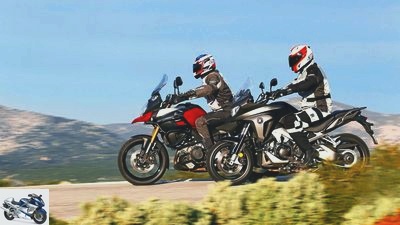
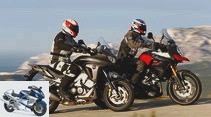
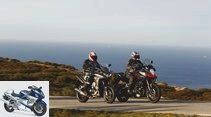
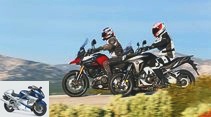
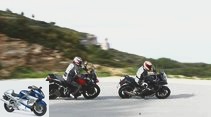
30th photos
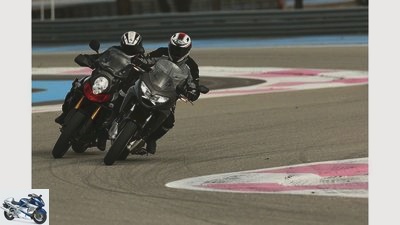
1/30
Honda Crossrunner and Suzuki V-Strom 1000 in comparison test.
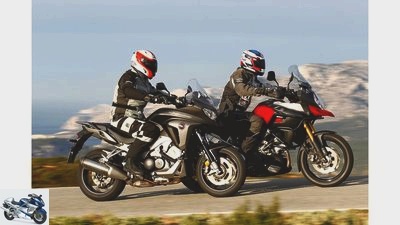
2/30
Honda Crossrunner and Suzuki V-Strom 1000 in comparison test.
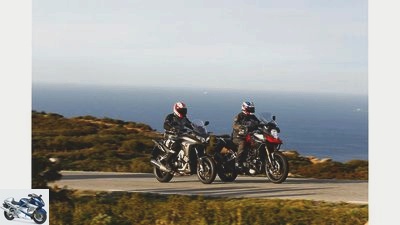
3/30
Honda Crossrunner and Suzuki V-Strom 1000 in comparison test.
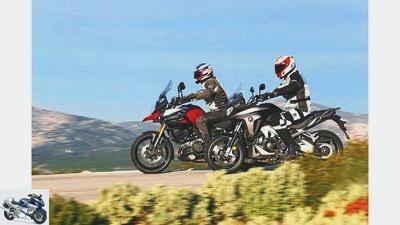
4/30
Honda Crossrunner and Suzuki V-Strom 1000 in comparison test.
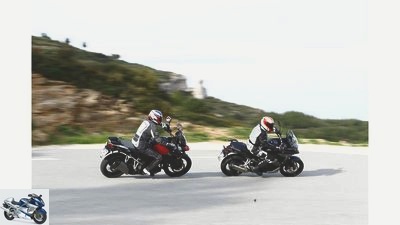
5/30
Honda Crossrunner and Suzuki V-Strom 1000 in comparison test.
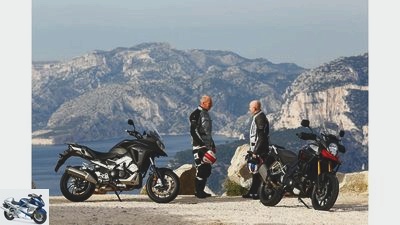
6/30
Honda Crossrunner and Suzuki V-Strom 1000 in comparison test.
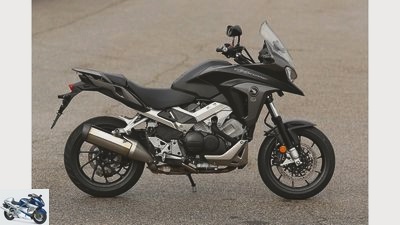
7/30
Honda Crossrunner.
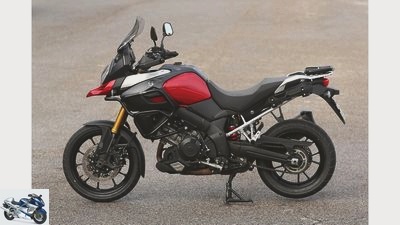
8/30
Suzuki V-Strom 1000.
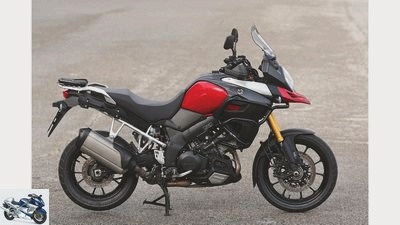
9/30
Suzuki V-Strom 1000.
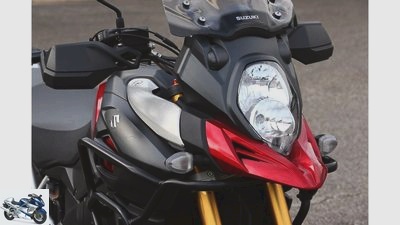
10/30
Suzuki V-Strom 1000.
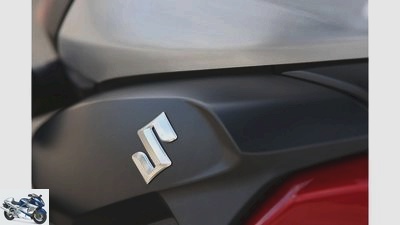
11/30
Suzuki V-Strom 1000.
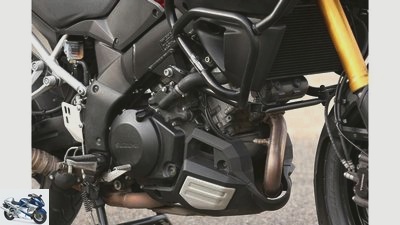
12/30
Suzuki V-Strom 1000.
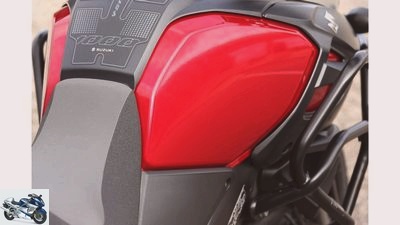
13/30
Suzuki V-Strom 1000.
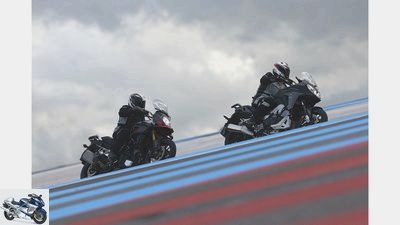
14/30
Honda Crossrunner and Suzuki V-Strom 1000 in comparison test.
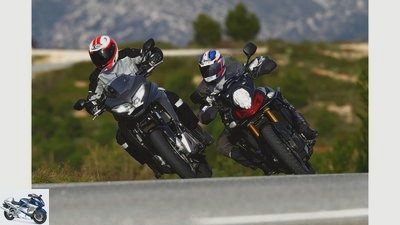
15/30
Honda Crossrunner and Suzuki V-Strom 1000 in comparison test.
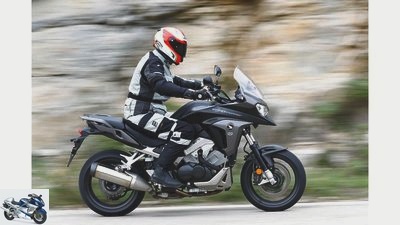
16/30
Honda Crossrunner.
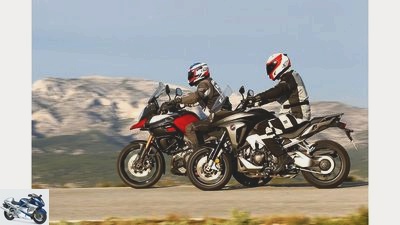
17/30
Honda Crossrunner and Suzuki V-Strom 1000 in comparison test.
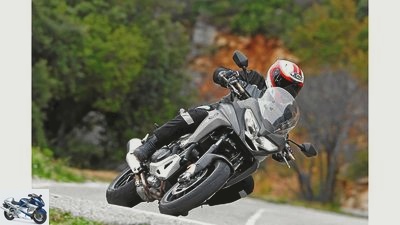
18/30
Honda Crossrunner.
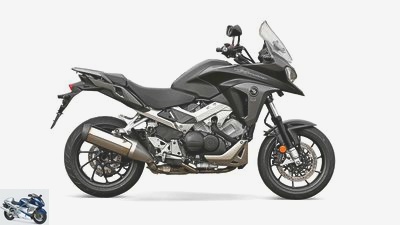
19/30
The seat of the revised Honda Crossrunner is height adjustable.
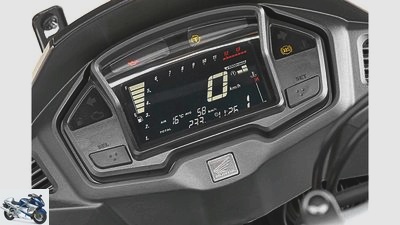
20/30
Honda relies entirely on digital displays. The disc is not height adjustable.
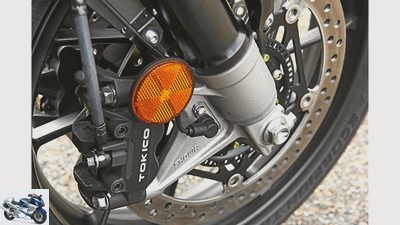
21/30
Radially mounted calipers on a conventional fork are rare.
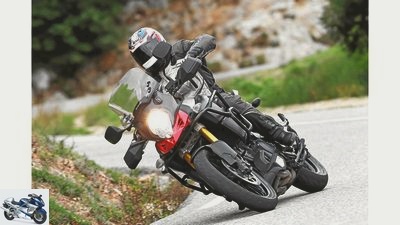
22/30
Suzuki V-Strom 1000.
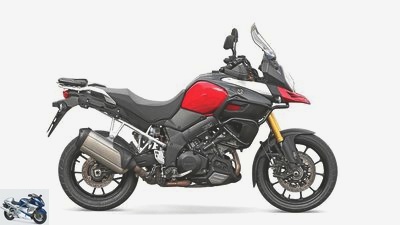
23/30
The seat of the Suzuki V-Strom 1000 forces the driver’s knees wide apart.
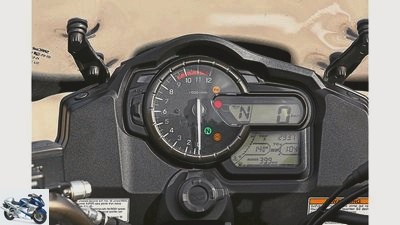
24/30
Suzuki prefers the analog tachometer and a prominent gear indicator.
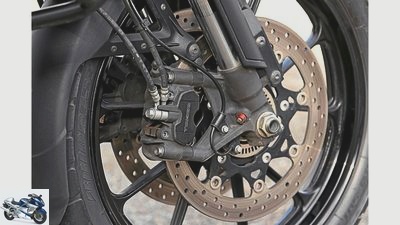
25/30
The upside-down fork of the Suzuki V-Strom 1000 can also be adjusted in compression.
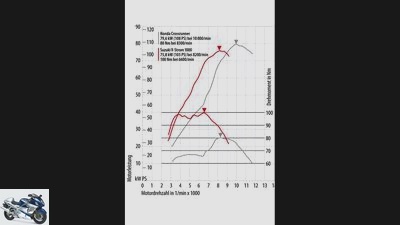
26/30
The impressive torque curve of the Suzuki V-Strom 1000 shows what the engineers aimed at when redesigning the engine: The former sports engine was trimmed to produce as much torque as possible at low speeds.
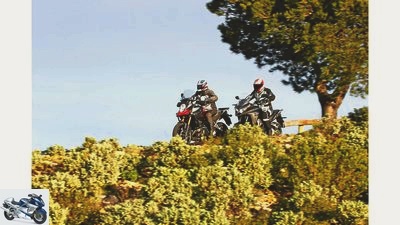
27/30
Honda Crossrunner and Suzuki V-Strom 1000 in comparison test.
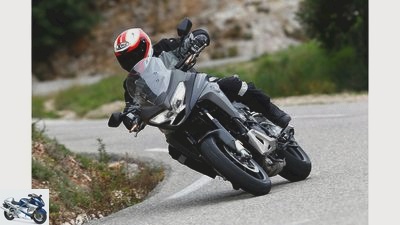
28/30
Honda Crossrunner.
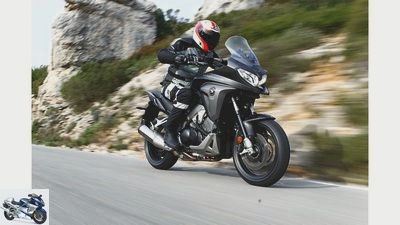
29/30
Honda Crossrunner.
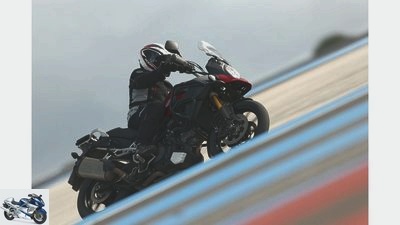
30/30
Suzuki V-Strom 1000.
Honda Crossrunner and Suzuki V-Strom 1000 in comparison test
Niche duel of travel enduro bikes
The Honda Crossrunner has more power than normal 800 cc touring enduros, and the Suzuki V-Strom 1000 with 1037 cm³ is between these and the 1200 cc. Because they are so different, both find their niche in the intermediate realm.
Who between the Honda C.Rossrunner and the Suzuki V-Strom 1000 switches back and forth, experiences two engine concepts that could hardly be more different. One would almost think that the developers, in a kind of reverse external control, avoided precisely those characteristics of their machine that are particularly pronounced in the other. That is of course not the case.
Buy complete article
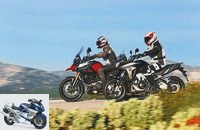
Honda Crossrunner and Suzuki V-Strom 1000 in comparison test
Niche duel of travel enduro bikes
Honda Crossrunner with the higher peak performance
Regarding the character differences mentioned: The Honda Crossrunner’s 782 V4 is a high-speed engine. At the bottom he pulls out without complaint, but not particularly committed. The term “tired” would also be allowed. When the mechanics of his Vtec system move him from a two-valve to a four-valve engine from 6500 rpm, the power and especially the torque take a steep upswing. Extrapolated to one liter of displacement, it exceeds the limit of 100 Nm and thus shows that it is a thoroughly efficient engine. Admittedly with characteristics that not everyone likes.
The V2 of the Suzuki V-Strom 1000 draws 100 Nm from 1037 cm³ displacement and is by far more powerful than the Honda V4. 20 Nm more at the top, which is also applied at a rested 6600 rpm, do their job. Even more: from just over 3000 to around 7000 rpm, the torque of the V-Strom is consistently over 90 Nm. Anyone can easily imagine how it feels when accelerating out of a curve – powerful. This feeling is proven by the much better pulling power of the Suzuki, while the acceleration values are determined continuously in the optimal speed range, in which the higher peak performance of the Honda Crossrunner works to your advantage.
In the upper speed range, when the Honda V4 ignites properly, the Suzuki V2 again slacks off. A comparatively early upshift at around 7500 rpm keeps it in the optimal range, spares your nerves and your wallet, while the Honda V4 likes to turn up to 11,000 rpm. In practice, unfortunately, nobody can drive the Honda Crossrunner exclusively in the area in which your engine feels particularly comfortable. On winding roads in particular, you constantly switch between two-valve operation below 6500 rpm and four-valve operation above it, especially since the Crossrunner is geared so long that the speed in tight bends drops far even in first gear. Many drivers are annoyed by the constant change in temperament and engine sound. Overall, the performance characteristics of the engine of the Suzuki V-Strom 1000 are much better suited to the purpose of the two motorcycles.
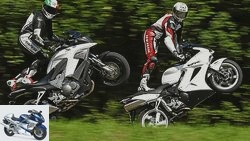
Tourer
Test: Honda Crossrunner against VFR 800
Honda tourer in comparison test
read more
Honda transmission with greater ease of use
However, when it comes to factors such as smooth running or throttle response, the pendulum swings in the direction of the Honda Crossrunner. The Suzuki V-Strom 1000 engine, which has been further developed since its debut in the Suzuki TL 1000 S with sometimes more and sometimes less vigor, is undoubtedly one of the most cultivated of the large two-cylinder engines. It only stomps when you torment it at low revs and vibrates only moderately. But the Honda V4 opens up a completely different level of running culture. In contrast to four-cylinder in-line engines, instead of vibrations, it only develops a gently massaging pulsation, which never feels tingly even at the highest speeds.
And although the drive train of the Suzuki V-Strom 1000 shows less play in load changes than that of the Honda Crossrunner, the Honda driver can get his machine back under tension more quickly at the apex of slow corners and with less effort on concentration. On pass roads, this makes up a few meters in every bend, which are gained without effort. The better shiftability of the Honda transmission also contributes to the impression of greater ease of use.
Suzuki V-Strom 1000 has longer caster and wheelbase
A look at the basic geometric data shows that the two candidates in this comparison also pursue very different goals when designing their chassis. This comparison is not just gray theory, but almost a teaching example of how the different characteristics of individual parameters are noticeable in driving practice. The Suzuki V-Strom 1000 has a longer caster and wheelbase than the Honda Crossrunner. Your steering head is one degree steeper than that of the Honda, but because of the different sizes of the front wheels, this value cannot be directly compared. The long wheelbase and caster of the Suzuki, and in part also the somewhat higher gyroscopic forces of the 19-inch front wheel, make it very stable in a straight line – at the price of higher steering forces. Despite its flatter steering head and wider tires, the Honda turns more easily.
In the area of medium inclines, the slight inertia of the Suzuki V-Strom 1000 turns into the opposite; it tips into lower altitudes faster than the driver would like. Especially when the grip conditions are not optimal, this tendency to tilt is irritating. It is quite possible that, in an attempt to overcome the aforementioned inertia, one pulls over something when turning in. After getting used to it, that goes away, but when you switch from one machine to another, the effect is always noticeable. With the series tires, the Bridgestone BW 501/502 in special specification “J”, it was lower than with the standard tires of this type and it could not be completely eliminated.

Motorsport
IDM Superbike 1000
De Boer is Yamaha’s hope
read more
Honda wants to be steered with a light hand
The shorter Honda Crossrunner not only turns easier, but also pampers you with homogeneous steering behavior. The prerequisite for this, however, is that the original ratio of front and rear height is maintained. In order to gain more lean angle in the blink of an eye, the testers simply tensioned the rear of the vehicle, but this caused a nervous steering behavior. Especially in deeper lean angles, the front wheel guidance appeared indifferent and no longer instilled absolute trust in the grip of the front tire. The wide handlebars also contribute to this, the leverage of which, in combination with the low steering forces, turns every small movement of the driver into an effective steering impulse. The Honda wants to be steered with a light hand.
Both motorcycles also showed major differences when it came to the coordination of the suspension elements. They ensure that the motorcycles behave differently than you would expect them to. The Suzuki is tightly tuned in terms of suspension and damping. This means that it can offer less suspension comfort than the softly sprung, gently dampened Honda Crossrunner despite longer suspension travel. And although the tire dimensions of the Suzuki V-Strom 1000 point at least a bit in the direction of off-road suitability, the Honda can cope better with bumpy slopes on its 17-inch wheels.
On the other hand, the sports tire dimensions of the Honda tires suggest a road sportiness that the motorcycle does not have at all. If you want to drive fast on winding roads in good weather and road conditions, the Suzuki V-Strom 1000 is much better off. The precise wheel guidance of the upside-down fork and ample damping reserves create confidence, while the Honda Crossrunner looks doughy and urges caution.
Technical data and measured values
markus-jahn.com
The Suzuki V-Strom 1000 has a longer caster and wheelbase than the Honda Crossrunner.
engine
| Honda Crossrunner | Suzuki V-Strom 1000 | |
| design type | Four-cylinder four-stroke- 90 degree V engine |
Two-cylinder four-stroke- 90 degree V engine |
| injection | 4 x Ø 36 mm | 2 x Ø 45 mm |
| coupling | Multi-panes- Oil bath clutch |
Multi-disc oil bath clutch (anti-hopping) |
| Bore x stroke | 72.0 x 48.0 mm | 100.0 x 66.0 mm |
| Displacement | 782 cc | 1037 cc |
| compression | 11.8: 1 | 11.3: 1 |
| power | 78.0 kW (106 hp) at 10,250 rpm |
73.5 kW (100 PS) at 8000 rpm |
| Torque | 75 Nm at 8500 rpm | 103 Nm at 4000 rpm |
landing gear
| Honda Crossrunner | Suzuki V-Strom 1000 | |
| frame | Bridge frame made of aluminium |
Bridge frame made of aluminium |
| fork | Telescopic fork, Ø 43 mm |
Upside-down fork, Ø 43 mm |
| Brakes front / rear | Ø 310/256 mm | Ø 310/260 mm |
| Assistance systems | ABS, traction control | ABS, traction control |
| bikes | 3.50 x 17; 5.50 x 17 | 2.50 x 19; 4.00 x 17 |
| tires | 120/70 R 17; 180/55 R 17 | 110/80 R 19; 150/70 R 17 |
| Tires | Pirelli Scorpion Trail | Bridgestone BW 501/502 “J” |
measurements and weight
| Honda Crossrunner | Suzuki V-Strom 1000 | |
| wheelbase | 1475 mm | 1555 mm |
| Steering head angle | 63.5 degrees | 64.5 degrees |
| trailing | 103 mm | 109 mm |
| Front / rear suspension travel | 145/148 mm | 160/160 mm |
| Seat height¹ | 810-830 mm | 860 mm |
| Weight with a full tank¹ | 245 kg | 249 kg² |
| Payload¹ | 187 kg | 191 kg |
| Tank capacity / reserve | 20.8 liters | 20.0 liters |
| Service intervals | 12,000 km | 12,000 km |
| price | 11,695 euros | 12,290 euros |
| Price test motorcycle | 11,695 euros | 13,664 euros³ |
| Additional costs | 295 euros | 250 euro |
MOTORCYCLE readings
| Honda Crossrunner | Suzuki V-Strom 1000 | |
| Top speed * | 209 km / h | 205 km / h |
| acceleration | ||
| 0-100 km / h | 3.7 sec | 4.0 sec |
| 0-140 km / h | 6.3 sec | 6.8 sec |
| 0-200 km / h | 15.8 sec | 19.4 sec |
| Draft | ||
| 60-100 km / h | 5.4 sec | 3.7 sec |
| 100-140 km / h | 6.4 sec | 4.2 sec |
| 140-180 km / h | 8.5 sec | 6.4 sec |
| Consumption country road / 100 km | 4.8 liters / super | 5.0 liters / normal |
| Reach country road | 433 km | 400 km |
* Manufacturer information; 1 MOTORCYCLE measurements; 2 with the accessories listed below; 3 crash bars (175 euros), pannier racks (232 euros), aluminum rack (107 euros), hand protectors (75 euros), heated grips (210 euros), main stand (200 euros), front spoiler (175 euros), tank pad (25 euros), Touring disc (175 euros).
Performance measurement
markus-jahn.com
Power on the crankshaft. Measurements on the Dynojet roller test stand 250, corrected according to 95/1 / EC, maximum possible deviation ± 5%.
The impressive torque curve of the Suzuki V-Strom 1000 shows what the engineers aimed at when redesigning the engine: The former sports engine was trimmed for as much torque as possible at low speeds. In complete contrast to this, the V4 of the Honda Crossrunner, which only really gets going when you have long been able to shift into the next gear on the V-Strom. The point at which the Honda-Vtec activates the second valve group and the engine is allowed to breathe through four valves becomes clear, but also less sharply than in previous years.
MOTORCYCLE scoring
markus-jahn.com
When it comes to the engine, the Suzuki V-Strom 1000 is one step ahead.
engine
| maximum number of points | Honda Crossrunner | Suzuki V-Strom 1000 | |
| Draft | 40 | 18th | 29 |
| acceleration | 40 | 24 | 19th |
| Top speed | 30th | 14th | 14th |
| Engine characteristics | 30th | 17th | 22nd |
| Responsiveness | 20th | 14th | 12th |
| Load change | 20th | 13 | 14th |
| Smoothness | 20th | 14th | 11 |
| coupling | 10 | 8th | 7th |
| circuit | 20th | 14th | 13 |
| Gear ratio | 10 | 7th | 8th |
| Start | 10 | 7th | 9 |
| total | 250 | 150 | 158 |
The Honda Crossrunner owes it to its acceleration and smoothness that it is only eight points behind the Suzuki V-Strom 1000 in this chapter. Your lower score in the “starting” criterion is due to a brief swallowing when starting up for the first time after a cold start. This was observed in two test copies.
Winner engine: Suzuki V-Strom 1000
landing gear
| maximum number of points | Honda Crossrunner | Suzuki V-Strom 1000 | |
| Handiness | 40 | 29 | 28 |
| Stability in turns | 40 | 26th | 28 |
| Steering behavior | 40 | 30th | 26th |
| feedback | 10 | 6th | 7th |
| Inclined position | 20th | 16 | 14th |
| Straight-line stability | 20th | 17th | 14th |
| Suspension tuning in front | 20th | 13 | 12th |
| Chassis set-up at the rear | 20th | 13 | 13 |
| Adjustment options undercarriage | 10 | 6th | 7th |
| Suspension comfort | 10 | 8th | 6th |
| Driving behavior with a passenger | 20th | 14th | 13 |
| total | 250 | 178 | 168 |
Soft or tight – both are possible if it’s done well. And they are well made, the Honda Crossrunner on the comfortable side, the Suzuki V-Strom 1000 on the sporty side. However, the unusual chassis geometry of the Suzuki also causes a not entirely homogeneous steering behavior.
Chassis winner: Honda Crossrunner
everyday life
| maximum number of points | Honda Crossrunner | Suzuki V-Strom 1000 | |
| Ergonomics driver | 40 | 30th | 29 |
| Ergonomics pillion | 20th | 14th | 13 |
| Windbreak | 20th | 12th | 14th |
| view | 20th | 12th | 13 |
| light | 20th | 15th | 13 |
| Furnishing | 30th | 23 | 25th |
| Handling / maintenance | 30th | 15th | 16 |
| Luggage storage | 10 | 1 | 5 |
| Payload | 10 | 5 | 5 |
| Range | 30th | 28 | 25th |
| processing | 20th | 14th | 13 |
| total | 250 | 169 | 171 |
In principle everything is fine with the ergonomics of the Suzuki, but you sit better on the Honda Crossrunner – even as a pillion passenger. At this point, a small, often ignored detail should be appreciated: The long mirror arms of the Suzuki V-Strom 1000 provide an exceptionally good view to the rear.
Winner everyday: Suzuki V-Strom 1000
security
| maximum number of points | Honda Crossrunner | Suzuki V-Strom 1000 | |
| Braking effect | 40 | 31 | 30th |
| Brake metering | 30th | 23 | 22nd |
| Braking with a passenger / fading | 20th | 14th | 13 |
| Righting moment when braking | 10 | 8th | 8th |
| ABS function | 20th | 14th | 14th |
| Handlebar slapping | 20th | 17th | 15th |
| Ground clearance | 10 | 8th | 8th |
| total | 150 | 115 | 110 |
They have almost identical brakes, and the Suzuki V-Strom 1000 no longer suffers from the Suzuki-typical, blunt friction pairing. Nevertheless, the brake of the Honda Crossrunner responds faster without being too snappy.
Safety winner: Honda Crossrunner
costs
| maximum number of points | Honda Crossrunner | Suzuki V-Strom 1000 | |
| Garamtie | 30th | 15th | 17th |
| Consumption (country road) | 30th | 20th | 19th |
| Inspection costs | 20th | 18th | 18th |
| Maintenance costs | 20th | 10 | 11 |
| total | 100 | 63 | 65 |
The Suzuki V-Strom 1000 owes the slightly lower maintenance costs to its cheaper, narrow tires.
Winner cost: Suzuki V-Strom 1000
| maximum number of points | Honda Crossrunner | Suzuki V-Strom 1000 | |
| Overall rating | 1000 | 675 | 672 |
| placement | 1. | 2. | |
| Price-performance note | 1.0 | 1.7 | 2.0 |
Price-performance winner: Honda Crossrunner
Three points more for significantly less money make any further explanation superfluous.
MOTORCYCLE test result
1. Honda Crossrunner
The Honda Crossrunner is the motorcycle for people who appreciate comfort and smoothness. Their solid workmanship and their high practical value make them an almost ideal partner for touring and everyday life.
2. Suzuki V-Strom 1000
More robust and powerful than the Honda, tighter and sportier, the Suzuki V-Strom 1000 distinguishes itself as the motorcycle for lovers of driving dynamics. Of course, it is still very suitable for long tours.
Related articles
-
Honda Africa Twin, KTM 1050 Adventure and Suzuki V-Strom 1000
markus-jahn.com 33 photos archive 1/33 Power on the crankshaft. Measurements on the Dynojet roller test stand 250, corrected according to 95/1 / EG,…
-
Comparison test touring enduro bikes: Honda Transalp, Kawasaki Versys, Suzuki V-Strom 650
Jahn comparison test travel enduro: Honda Transalp, Kawasaki Versys, Suzuki V-Strom 650 Always on the wall, travel enduro does not necessarily mean BMW …
-
Suzuki V-Strom 1000 in the top test
fact 26th photos fact 1/26 First of all, the meticulousness with which Suzuki’s technicians and engineers went to work is surprising. The new V-Strom,…
-
BMW F 800 GT, Kawasaki Z 1000 SX and Honda VFR 800 F in the test
fact 44 pictures fact 1/44 fact 2/44 fact 3/44 fact 4/44 fact 5/44 Praise to the diversity: The three test candidates all want the same thing, but are looking for it …
-
Suzuki V-Strom 650 and Suzuki V-Strom 1000 in comparison test
fact 8th photos fact 1/8 With a torque plateau already starting at 3500 rpm, the test bench also demonstrates the punch of the Suzuki V-Strom 1000 in the…
-
Jahn comparison test of supersports: Ducati 998, Honda Fireblade, Kawasaki ZX-9R, Suzuki GSX-R 1000, Triumph Daytona 955i Centennial The K-Question Five …
-
fact Concept comparison Honda CBR 1100 XX Kawasaki ZX-12 R Suzuki GSX-R 1000 Suzuki GSX 1400 Yamaha FZS 1000 Fazer Yamaha FJR 1300 Six bombs The six …
-
Comparison test Honda Fireblade, VTR 1000 SP-2
Artistic comparison test Honda Fireblade, VTR 1000 SP-2 Everything stays different Honda is the only motorcycle manufacturer to produce two 1000cc super sports …
-
Honda Fireblade vs. Suzuki GSX-R 1000 in comparison test
Maccabelli The last four-cylinder without control electronics Test: Honda Fireblade against Suzuki GSX-R 1000 Contents of They are the last current …
-
Suzuki GSX-R 750 – GSX-R 1000 in comparison test
Rivas Family duel: Suzuki GSX-R 750 / GSX-R 1000 The super athletes from Suzuki in comparison test The GSX-R sisters are visually difficult to…